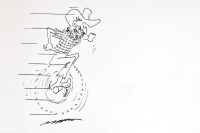Warm weather brings unseasonable activity
Cutting collards this past weekend, I was surprised to find colonies of purplish-colored aphids under many of the leaves.
That discovery spurred me into a more extensive garden inventory. I discovered several of the more tender greens, such as the Asian introductions Tokyo Bekana and Vitamin Green, bore evidence of feeding insects. There were shotgun patterns of holes marring these tasty plants’ leaves.
When later I jerked a length of row cover from a shelf in the garden storage shed, the abrupt movement disturbed a small village of Asian beetles. The honeybees, too, were actively in search of something to feed upon. But because they fly from the hive at temperatures roughly 50 degrees or warmer, this wasn’t as profound a marker of the unseasonable-ness of our recent weather as other insect types.
This is the first time I can remember such vigorous insect activity this late (or should that be early) in the year. I’m certain we’ve had similar warm, early winter weather in past years; until I became a gardener there was little reason to note such events in my memory bank. Which is an excellent reason, among many excellent reasons, to garden. One immediately becomes an acute, if amateur, observer of nature; and a historian of sorts regarding previous garden seasons and anomalies accompanying them.
The surge of insect activity hadn’t been isolated to the garden. I’d noticed, but not attended to the why, our hens were ranging farther and farther from where their laying pellets are kept. The insect populations clearly must have rebounded elsewhere, too. The hens this past week could be viewed happily tossing the leaf litter on the forest floor like so many industrious chicken leafblowers. They must have been uncovering and devouring newly emerging or reemerging bugs and worms.
The weather forecasters, however, warned of an impending deep freeze while I snacked in front of the local news broadcast hours after devouring a requisite helping of hoppin’ john. The winds indeed were gusting by nightfall of the new year’s first day. A burst of Arctic air, as the television weather woman ominously and breathlessly termed the incoming assault, accompanied most likely by accumulating snow. That sounded brutal, but such cold certainly would prove much more painful for the insects than me, given my ability to hole up, sheltered, by a warm fire. An “Arctic blast” would end not only their unseasonable romps through the garden, but indeed through life.
Related Items
A New Year’s Day visitor noticed the honeybees flying from the hives perched on the hill above the house and asked how well they winter. Perfectly, I responded, unless they get wet, diseased or starve to death.
Honeybees in cold weather form a cluster, a huddle, to protect themselves and most importantly, to shelter the brood and queen. Honeybees during cold spells will disconnect their wing muscles from their wings. This allows them to more easily vibrate and, in this manner, generate lifesaving and life-giving warmth. The temperature inside of the cluster containing the precious queen and brood has been measured at a consistent, and balmy, 92 degrees.
The outermost honeybees periodically move into the center of the huddle to stay warm, leaving other honeybees for a time to endure the cold’s brunt on the cluster’s parameter. There is a constant in and out flow to a winter cluster, a cycle as perpetual as the movement of waves on an ocean, ever coming and going. I find this enjoyable to ponder when having an insomniac moment on a cold night.
I have sugar water prepared to go on the hives into hive-top feeders. This should have been fed to the honeybees already, but an attack of a plague-like illness sent me to bed, to weakened even to care for the bees. I had hoped to send them into this cold weather as prepared as possible. Fat and sassy, scoffing even at the promised Arctic blast and accumulating snowfall.
There’s little doubt that honeybees will be starving this winter across Western North Carolina if beekeepers neglect feeding them. The warm weather means they’ve likely been eating their stores at a torrid pace.
Starvation, even in colder winters than this one, is the most common method of death for honeybee colonies.
The beekeeper can know she’s starved her charges quite easily — you raise the cover and inner lid of a hive to discover the honeybees’ butts in the air, dead facedown into the comb cells. They starved there while searching in vain for something to eat. This is a sad, discouraging sight indeed for any beekeeper, maybe the worst one I know when it comes to honeybees. Because it’s so clearly the result of preventable neglect; akin to the act of leaving a dog in a car with rolled up windows on a hot summer day. Or tethering a goat unwatched to feed on weeds, like so much bait on a fishing line for marauding neighborhood dogs.
(Quintin Ellison can be reached at This email address is being protected from spambots. You need JavaScript enabled to view it..)









